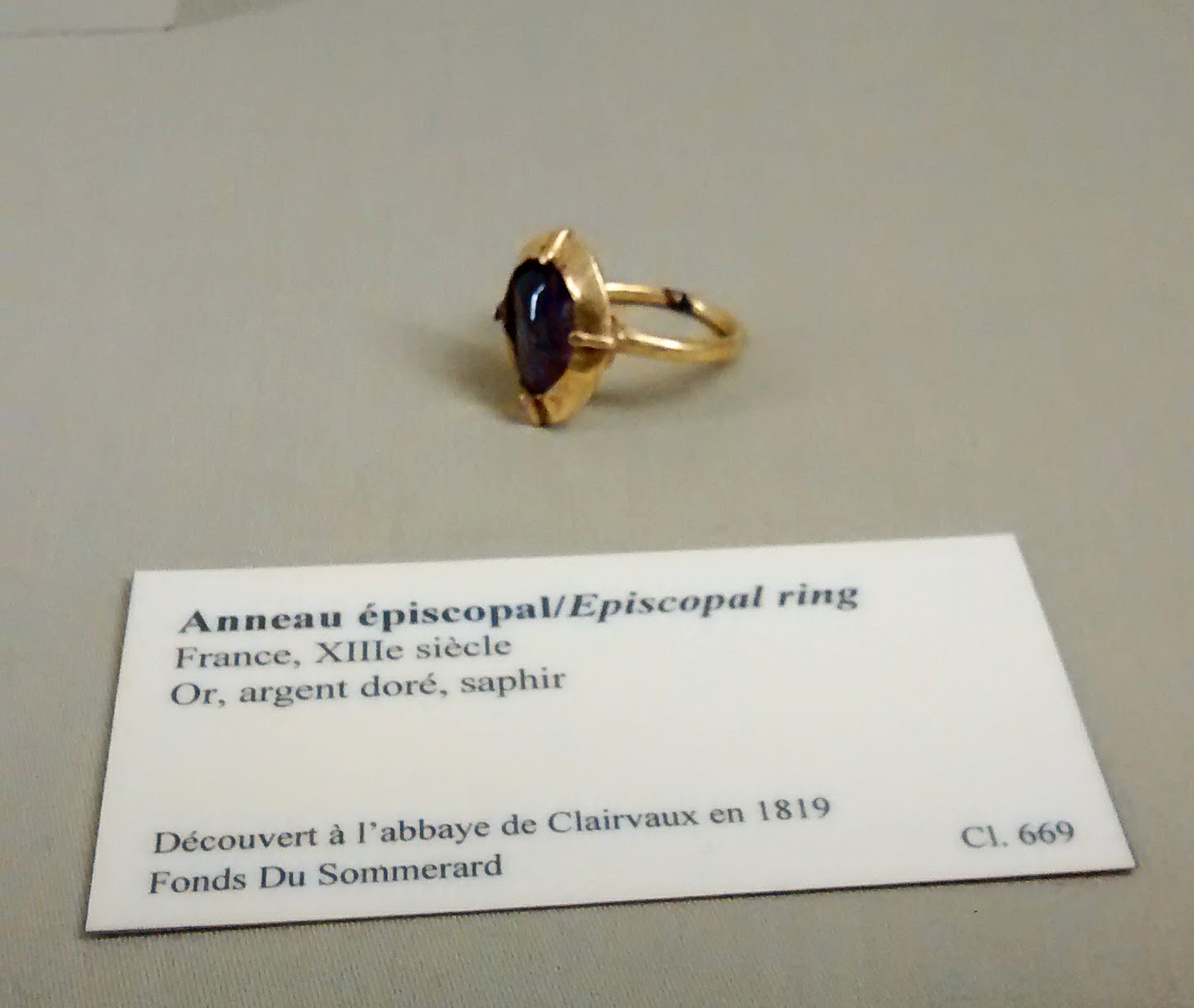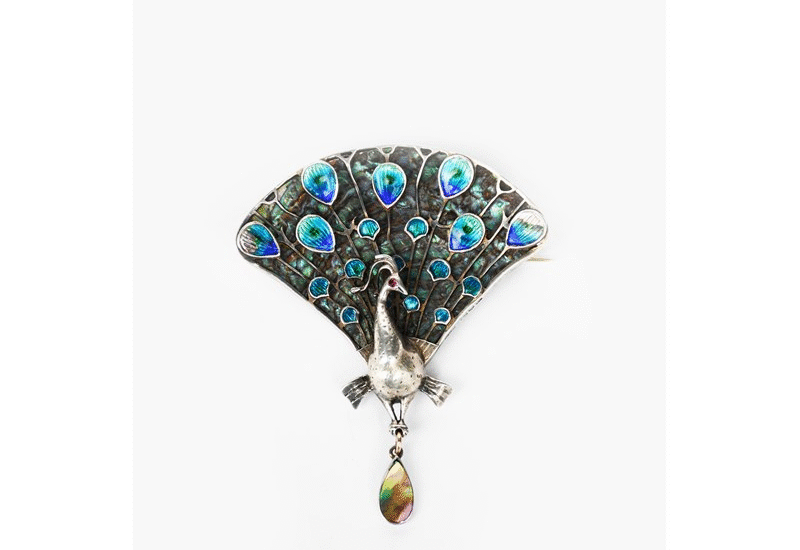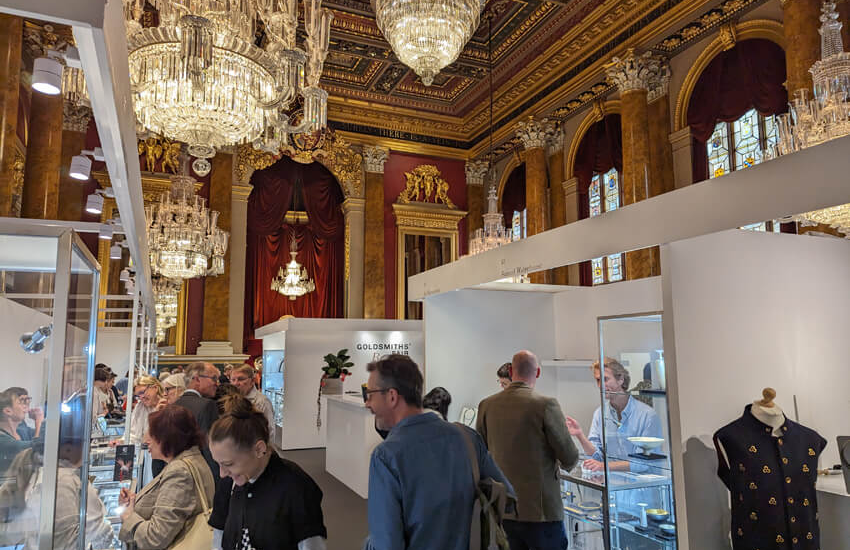How to display jewellery in a museum
Almost every museum has a collection of jewellery – whether collected as a decorative art, as a part of costume or to support a social history collection. However, it can be one of the most difficult types of objects to display. So, what should we think about when planning how to display jewellery in a museum?
Jewellery in a temporary space, like a craft show or a temporary exhibition, can be arranged as imaginatively as you like. However, most museum displays are expected to last many years. There is rarely the time or money to redo a permanent display so it’s essential to choose a display which won’t look dated in a few years and which suits the conservation needs of the objects.
Many museums don’t have a dedicated display team, so here are a few ideas based on my experience curating jewellery at the Victoria and Albert Museum.
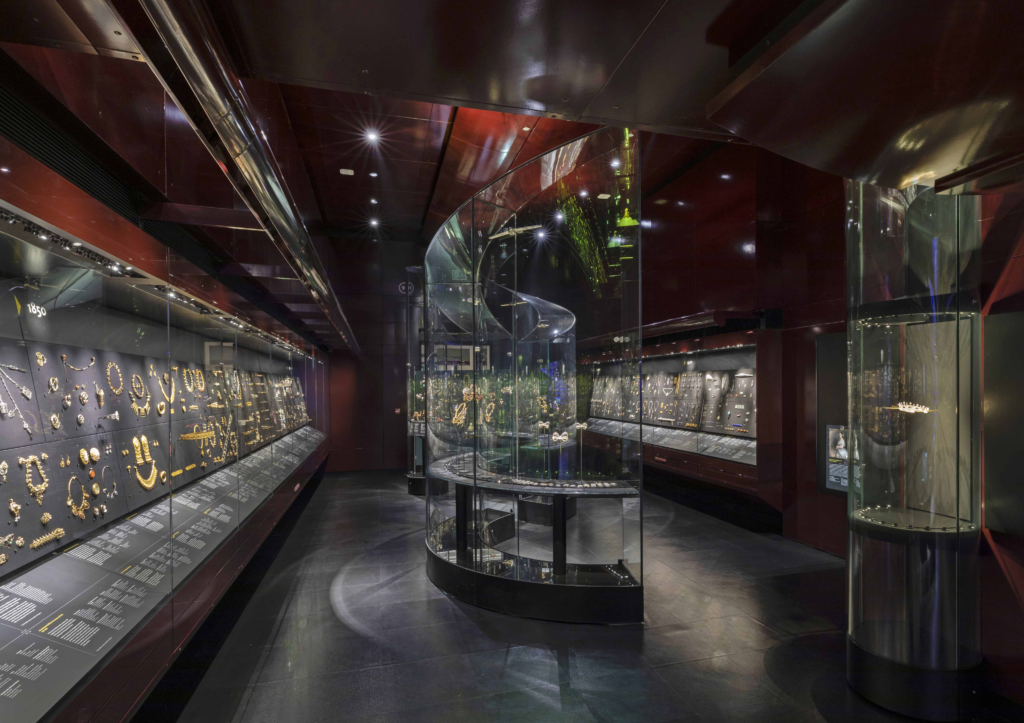
A dedicated space like the Victoria and Albert Museum’s Jewellery Gallery allows the displays to be entirely focused on making the jewellery look wonderful. Lighting, temperature and humidity can be controlled in order to keep the objects in good condition.
However, most museum jewellery displays will be placed in general galleries or alongside mixed materials and compromises may be necessary.
Size and scale
Jewellery is scaled to the human body and can often be very small. Rings, my former speciality, are often quite modest objects, although fascinating. Jewels were often intended to be viewed close up, or held in the hand and the decoration often carried around to the back or interior of the jewel. Displaying these small objects in a way which allows the fine detail to be appreciated can be a challenge.
Small pieces of jewellery tend to get lost in a large or mixed display – if you place a small piece of jewellery next to a large ceramic, for example, it will struggle to hold its own. If you want to appreciate the intricate detail of a jewel, it’s better to display it separately if possible, or if not, placed towards the front of the showcase with space around it.

Oxford’s Ashmolean Museum cases use an ingenious octagonal shape to bring the rings collection to the fore. The sloping sides of the case allow the rings to be viewed easily and lighted from above.
In some cases, displaying jewels alongside larger objects can work. Placing a jewel close to a related design can offer an interesting link and demonstrate how the design has been utilised. Using a necklace or brooch as part of a costume display can also help build a picture of how the jewel was worn. It can work to display it directly on the mannequin or fixed to the costume, but the jewel itself will be more of an accessory than shown off in its own right. However, paper and textiles need a much lower level of lighting than most jewellery. Displaying jewels near light sensitive materials can mean that the jewel itself can’t be lit to best advantage.
Materials
Tradional jewellery materials are reasonably straightforward. Metals are not sensitive to light and as long as humidity levels are kept under control, they will not deteriorate while on display. Gemstones are also fairly impervious.
However, jewellery is often made up of mixed materials, which can pose problems in a museum display. This is especially true of contemporary studio jewellery which often includes non-traditional materials, found objects and organic materials. These can be a real challenge to display safely as they may be sensitive to light or temperature fluctuations, or possibly give off gases which will cause deterioration in nearby objects.
For example, Bettina Dittlmann’s Millenium Bridge necklace is placed in its own perspex box in the V&A Jewellery Gallery. It’s made up of found clay pipe fragments on iron wire and there was a worry that it might give off gases which would oxidise other objects in the case. Isolating it in a sealed box meant that it could be displayed alongside other jewels without damaging them.
Sometimes historic jewels include hair or other organic materials which are sensitive to light levels and may be a risk for pest infestations. Enamels are vulnerable to sudden changes in temperature which can cause the metal foundation to expand at a different rate to the enamel, causing an irreparable break. Few things are more demoralising than opening up a case to see that your beautiful enamel has shattered into tiny pieces.
Organic materials should be shielded from excess humidity – the generally accepted range is between 40 to 65 % relative humidity. Too dry and materials like ivory may crack, too wet and your hair jewellery or textiles start to grow mould.
The aim of a good museum case or store is to keep temperature and humidity fluctuations within a reasonable range and to avoid sudden changes as much as possible. Cases can be conditioned with silica gel while a tight fitting case door will minimise air exchange and keep the interior conditions more stable. Controlling overall light levels by fitting blinds to outside windows can also help to keep conditions stable.
Mounts
As jewellery is made for the body, it is rarely self supporting. In order to display it, it must generally be pinned to a support or have a mount made to hold it. The ideal mount will be as discreet as possible while supporting the jewel safely. It should also be made of materials which will be neutral and any sharp edges should be covered with plastic tubing or similar.
Pinning jewels to a supporting board is a popular option for many displays. The board can be covered with a fabric layer to which jewels can be pinned or sewn very discreetly. The fabric itself should be ‘Oddy’ tested to make sure it doesn’t contain harmful chemicals. This is a very flexible display method which is easy to change.
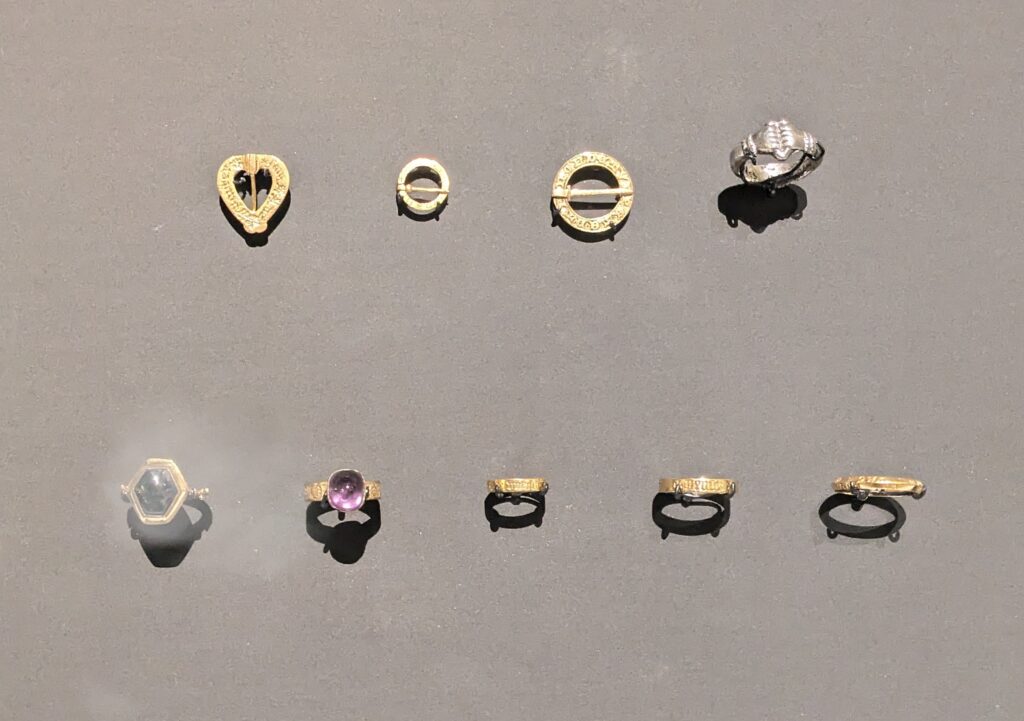
These are two different ways to attach jewellery to a backboard. The top row are pinned with metal pins covered in plastic tubing. The second row uses plastic ring mounts – adjustable shapes which slip inside the hoop of the ring and which have a pin on the back to go through the board.
Both methods are secure and discreet.
Mounts screwed into a hardboard or acrylic backboard are also possible, although this is less flexible. It’s even possible to use magnetic fittings on a metal board. One point to consider, try to bring the jewellery close to the front of the display case so that it is easily visible and can be properly lit.
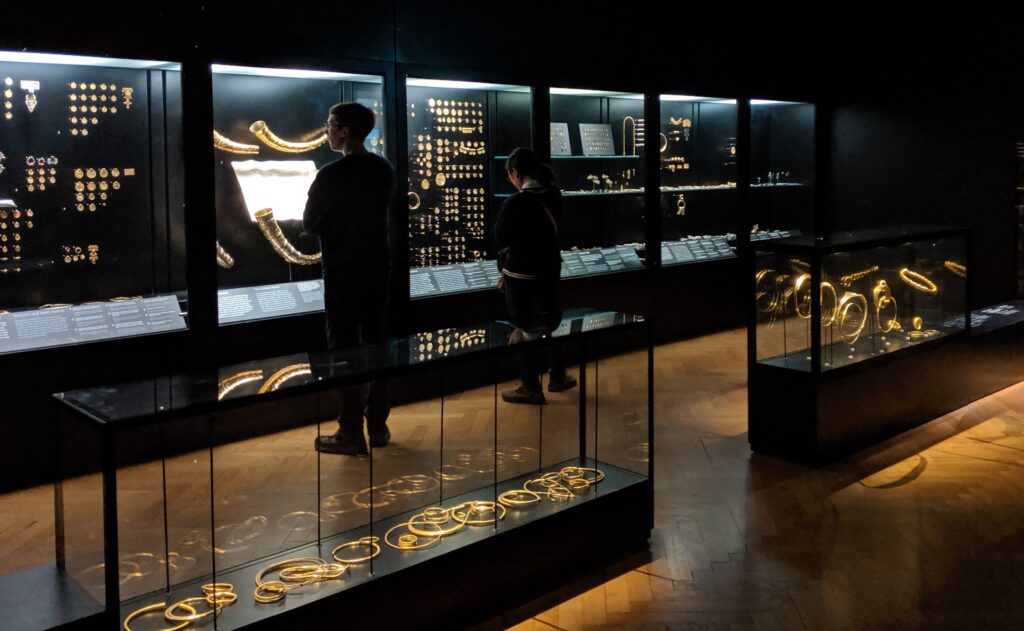
In the National Museum of Denmark’s displays, the massed torcs in the bottom of the case give an impression of plenty and are a reminder of the hoards they originated from. Other objects are mounted on metal prongs within a freestanding case or pinned to the backboards of wall cabinets.
Depending on the available budget, free standing objects can be displayed on custom made mounts. When placed in a free standing case, jewels can be viewed in the round, allowing the whole object to be appreciated. If you want to give the appearance of jewels floating in space, they can be suspended from a case top with mono-filament. Metal mounts can sometimes overpower the display – to avoid this, matching the colour to the overall case display helps them to fade into the background.
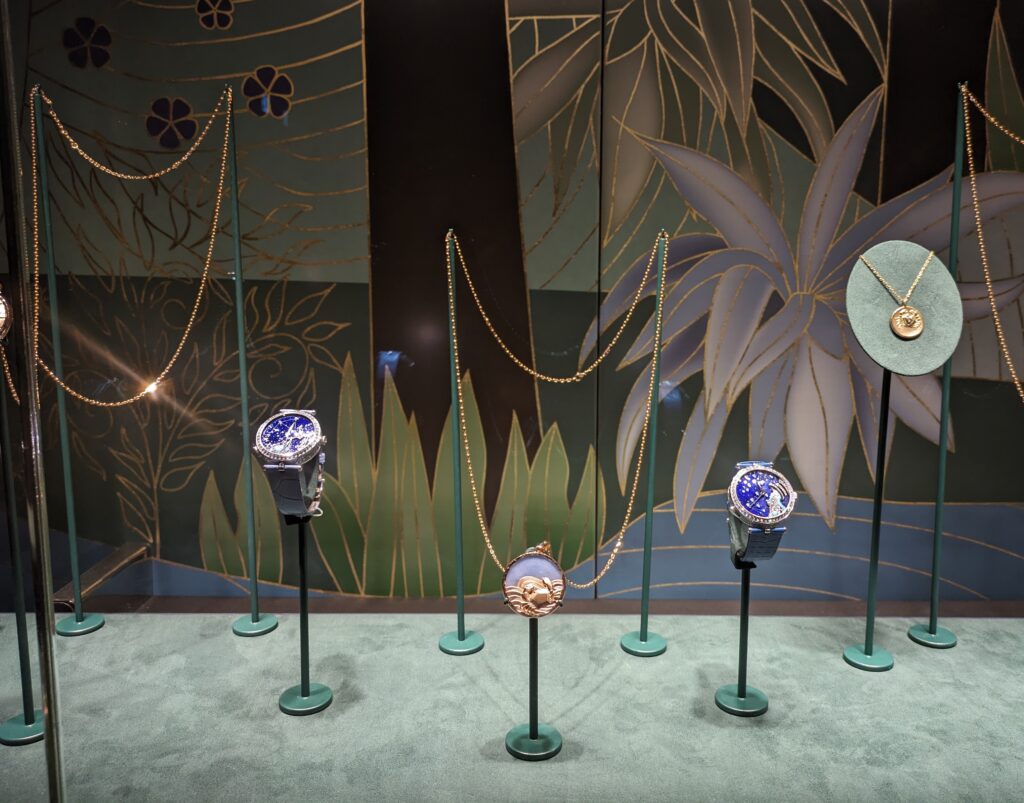
Contemporary artist jewellery may lend itself to innovative or playful methods of display but thinking about the life span of the display should discourage choosing anything too gimmicky.
Security
Security is a particular problem for many jewels as their raw materials have a measurable value. A jewel can be broken up for the gold or gemstones it contains, although the value of the materials is generally far lower than its value as a work of art.
Displays should offer good case security as well as perimeter security for the gallery or venue. In general, jewellery displays shouldn’t be placed near a street exit or in a blind spot.
If security is a particular concern, it may be wise to put all precious metal or gem-set jewels together in one high security showcase.
Lighting
Lighting is one of the biggest challenges when displaying jewellery. Gemstones need bright light in order to sparkle while intaglio designs and engraving rely on carefully positioned lights to show their fine detail. Some organic materials such as paper, textiles or hair will be damaged by high light levels and should be displayed in a way which reflects this.
Light sensitive objects can be placed on the edge of displays with the lights angled away or put into drawers where they will be shielded from light for the majority of the time. This will allow the overall gallery light levels to be higher.
Flexibility is the key to successful lighting. Fibre optic lights within the showcase combined with adjustable track lighting will allow the curator to angle lights in a way which brings out the best qualities of the jewellery while avoiding obtrusive shadows. Being able to light objects from different angles is vital to achieving a pleasing display.
If funds allow, non-reflective glass makes an enormous difference to displays, avoiding distracting reflections from lights.
Labels
A museum display often aims to tell a story, visually but also through supporting text. As jewels are often small, it’s possible to fit a large number of objects into a small area. How much information do your visitors need in order to enjoy the display and what is the best medium for communicating with them?
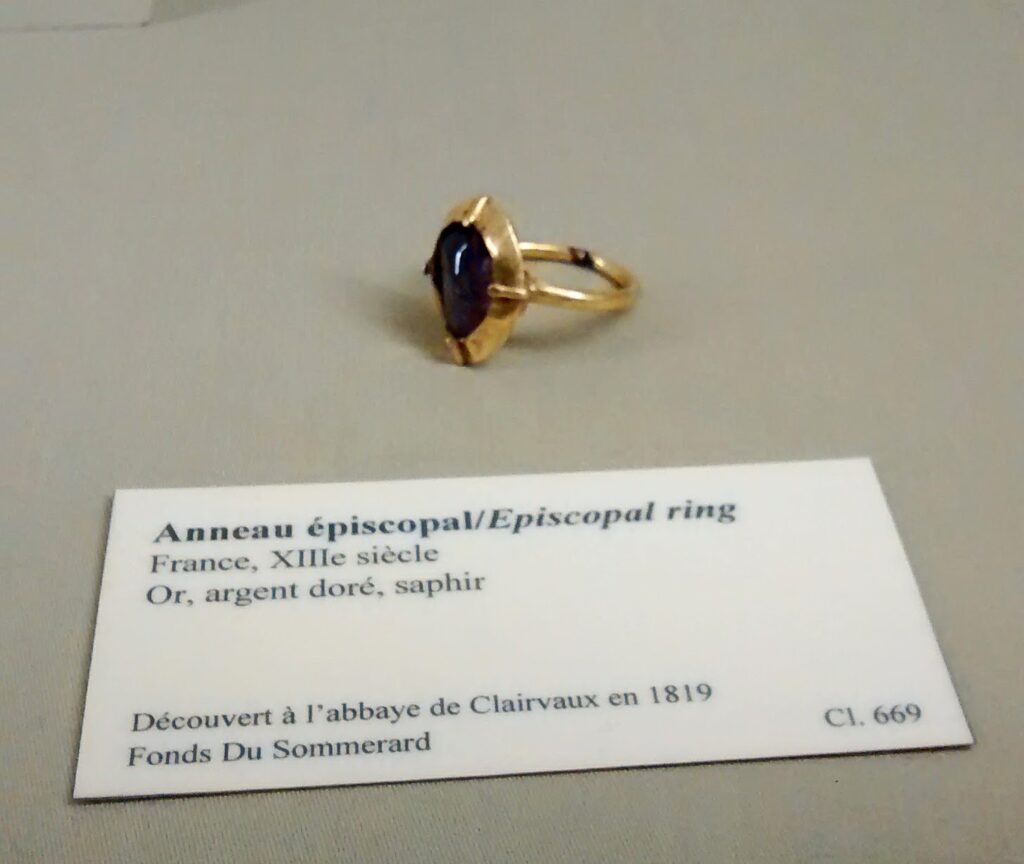
As jewels are often small, it’s possible to fit a large number of objects into a small area. This can be a problem – how do you fit object labels into a display when the label may be far larger than the object it is supporting?
One possible option is to keep the label text very brief but direct the visitor to a computer database for fuller details, either within the gallery space or via a mobile device. An interface in the gallery is available to any visitor but needs to be maintained. Out of order signs on interactives are a depressing sight in a gallery. It also places the explanatory text away from the physical object and breaks up the narrative of the display. Technology changes rapidly and gallery computer interactives rely on a budget for maintenance and upkeep as well as regular updates.
Some museums now supply label text via QR codes accessed through the visitor’s own mobile device and the gallery WiFi. This is easy to update, can be available in multiple languages and doesn’t rely on the museum supplying or maintaining any hardware. It can also be a good option for accessibility, allowing audio description or text reading software. However, it can exclude visitors who don’t have access to smart phones and takes the visitor’s attention away from the display to their phone screen.
A gallery book can be a low tech option, allowing longer text than a label in the case. These are easy to access for most visitors However, these can be cumbersome to update and off-putting for a visitor to carry around. It’s also necessary to find space in the display to store them and there is a need for repairs and maintenance.
As a general rule, short text close to the object, supported by more comprehensive information in a gallery book or database is the best way to provide information to the visitor and support the displays.
Final thoughts
The challenge for the curator is to create a beautiful and meaningful display while respecting the conservation and security needs of the objects. Done well, a jewellery display can be a popular and engaging part of a museum gallery.
Carefully considering the budget available for lighting, mounts and display cases, the security and conservation needs of the objects and the most effective way to provide information will help to create a pleasing and durable display.
Here’s a list of some great museum jewellery displays.
